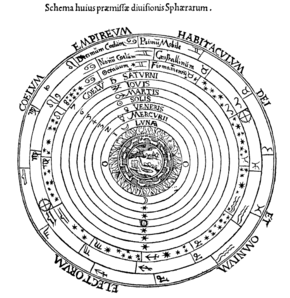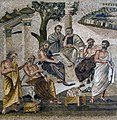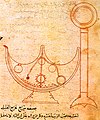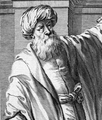Portal:History of science
The History of Science Portal
The history of science covers the development of science from ancient times to the present. It encompasses all three major branches of science: natural, social, and formal. Protoscience, early sciences, and natural philosophies such as alchemy and astrology during the Bronze Age, Iron Age, classical antiquity, and the Middle Ages declined during the early modern period after the establishment of formal disciplines of science in the Age of Enlightenment.
Science's earliest roots can be traced to Ancient Egypt and Mesopotamia around 3000 to 1200 BCE. These civilizations' contributions to mathematics, astronomy, and medicine influenced later Greek natural philosophy of classical antiquity, wherein formal attempts were made to provide explanations of events in the physical world based on natural causes. After the fall of the Western Roman Empire, knowledge of Greek conceptions of the world deteriorated in Latin-speaking Western Europe during the early centuries (400 to 1000 CE) of the Middle Ages, but continued to thrive in the Greek-speaking Byzantine Empire. Aided by translations of Greek texts, the Hellenistic worldview was preserved and absorbed into the Arabic-speaking Muslim world during the Islamic Golden Age. The recovery and assimilation of Greek works and Islamic inquiries into Western Europe from the 10th to 13th century revived the learning of natural philosophy in the West. Traditions of early science were also developed in ancient India and separately in ancient China, the Chinese model having influenced Vietnam, Korea and Japan before Western exploration. Among the Pre-Columbian peoples of Mesoamerica, the Zapotec civilization established their first known traditions of astronomy and mathematics for producing calendars, followed by other civilizations such as the Maya.
Natural philosophy was transformed during the Scientific Revolution in 16th- to 17th-century Europe, as new ideas and discoveries departed from previous Greek conceptions and traditions. The New Science that emerged was more mechanistic in its worldview, more integrated with mathematics, and more reliable and open as its knowledge was based on a newly defined scientific method. More "revolutions" in subsequent centuries soon followed. The chemical revolution of the 18th century, for instance, introduced new quantitative methods and measurements for chemistry. In the 19th century, new perspectives regarding the conservation of energy, age of Earth, and evolution came into focus. And in the 20th century, new discoveries in genetics and physics laid the foundations for new sub disciplines such as molecular biology and particle physics. Moreover, industrial and military concerns as well as the increasing complexity of new research endeavors ushered in the era of "big science," particularly after World War II. (Full article...)
Selected article -

The celestial spheres, or celestial orbs, were the fundamental entities of the cosmological models developed by Plato, Eudoxus, Aristotle, Ptolemy, Copernicus, and others. In these celestial models, the apparent motions of the fixed stars and planets are accounted for by treating them as embedded in rotating spheres made of an aetherial, transparent fifth element (quintessence), like gems set in orbs. Since it was believed that the fixed stars did not change their positions relative to one another, it was argued that they must be on the surface of a single starry sphere.
In modern thought, the orbits of the planets are viewed as the paths of those planets through mostly empty space. Ancient and medieval thinkers, however, considered the celestial orbs to be thick spheres of rarefied matter nested one within the other, each one in complete contact with the sphere above it and the sphere below. When scholars applied Ptolemy's epicycles, they presumed that each planetary sphere was exactly thick enough to accommodate them. By combining this nested sphere model with astronomical observations, scholars calculated what became generally accepted values at the time for the distances to the Sun: about 4 million miles (6.4 million kilometres), to the other planets, and to the edge of the universe: about 73 million miles (117 million kilometres). The nested sphere model's distances to the Sun and planets differ significantly from modern measurements of the distances, and the size of the universe is now known to be inconceivably large and continuously expanding. (Full article...)
Selected image

Part of Charles Babbage's Difference Engine was assembled after his death by Babbage's son, using parts found in his laboratory. The brass parts were machined by the toolmaker Joseph Clement. Babbage never completed his difference engine, partly due to problems with friction and machining accuracy, but also because he kept changing the design. Henry Provost Babbage inherited the pieces following his father's death in 1871, and some years later in 1879 he assembled several working sections of the full machine. Possibly as many as seven assembled sections exist. This portion, in the Whipple Museum of the History of Science of the University of Cambridge, demonstrates how the addition and carry mechanism works.
Did you know
...that Einstein's famous letter to FDR about the possibility of an atomic bomb was actually written by Leó Szilárd?
...that geology was transformed in the latter part of the 20th century after widespread acceptance of plate tectonics?
...that the idea of biological evolution dates to the ancient world?
Selected Biography -
Alan Mathison Turing (/ˈtjʊərɪŋ/; 23 June 1912 – 7 June 1954) was an English mathematician, computer scientist, logician, cryptanalyst, philosopher and theoretical biologist. He was highly influential in the development of theoretical computer science, providing a formalisation of the concepts of algorithm and computation with the Turing machine, which can be considered a model of a general-purpose computer. Turing is widely considered to be the father of theoretical computer science.
Born in London, Turing was raised in southern England. He graduated from King's College, Cambridge, and in 1938, earned a doctorate degree from Princeton University. During World War II, Turing worked for the Government Code and Cypher School at Bletchley Park, Britain's codebreaking centre that produced Ultra intelligence. He led Hut 8, the section responsible for German naval cryptanalysis. Turing devised techniques for speeding the breaking of German ciphers, including improvements to the pre-war Polish bomba method, an electromechanical machine that could find settings for the Enigma machine. He played a crucial role in cracking intercepted messages that enabled the Allies to defeat the Axis powers in many engagements, including the Battle of the Atlantic. (Full article...)
Selected anniversaries
- 1757 - Birth of Samuel Bentham, English mechanical engineer (d. 1831)
- 1787 - William Herschel discovers Titania and Oberon, two moons of Uranus
- 1788 - Birth of William Thomas Brande, English chemist (d. 1866)
- 1800 - Birth of Ányos Jedlik, Hungarian physicist (d. 1895)
- 1839 - Birth of Eugenio Maria de Hostos, Puerto Rican educator, philosopher and nationalist (d. 1903)
- 1845 - Birth of Albert Victor Bäcklund, Swedish physicist (d. 1912)
- 1850 - Birth of Joseph Charles Arthur, American botanist (d. 1942)
- 1872 - Birth of George Washington Pierce, American physicist (d. 1956)
- 1882 - Death of Theodor Schwann, German physiologist (b. 1810)
- 1887 - Birth of Aldo Leopold, American ecologist (d. 1948)
- 1906 - Birth of Albert Hofmann, Swiss chemist (d. 2008)
- 1924 - Birth of Roger Guillemin, French neuroendocrinologist, Nobel laureate
- 1968 - Death of Isidor Isaac Rabi, American physicist, Nobel Prize laureate (b. 1898)
- 1991 - Death of Carl David Anderson, American physicist, Nobel laureate (b. 1905)
Related portals
Topics
General images
Subcategories
Things you can do
Help out by participating in the History of Science Wikiproject (which also coordinates the histories of medicine, technology and philosophy of science) or join the discussion.
Associated Wikimedia
The following Wikimedia Foundation sister projects provide more on this subject:
-
Commons
Free media repository -
Wikibooks
Free textbooks and manuals -
Wikidata
Free knowledge base -
Wikinews
Free-content news -
Wikiquote
Collection of quotations -
Wikisource
Free-content library -
Wikiversity
Free learning tools -
Wiktionary
Dictionary and thesaurus









































































